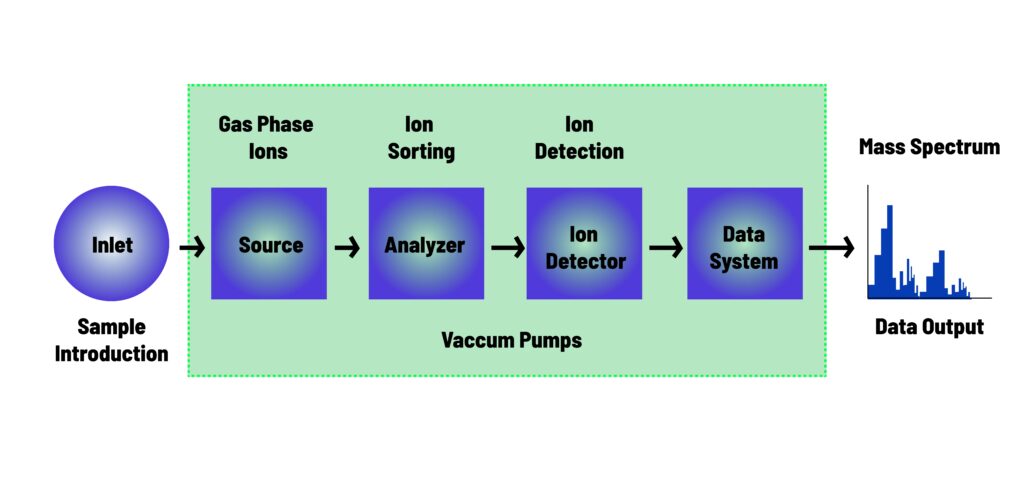What is Mass Spectrometry?
This process is an instrumental method in which a sample is changed to fast moving positive ions by electron bombardment. The charged particles vary due to their different mass to charge ratio and are estimated with the help of this difference. It is also called mass spectroscopy.
Introduction
It is the accurate method for determining the molecular mass of the compound and its elemental composition. In this technique, the compound remains under investigation or analysis and is bombarded with the beam of energetic electrons. As a result of this, the molecules are ionized and dissociate into several fragments which have their own characteristic charge to mass ratio.
Mass spectrometry is not a true spectroscopic method. The reason behind this is that the absorption of electromagnetic energy is not involved in any way in this method. This method has applications in analytical chemistry. With the help of this method one can easily find the molecular mass of the high energetic ions or molecules accurately.
Mass Spectrometer
A mass spectrum consists of an array of peaks of different heights. The nature of the spectrum is dependent on the properties of the molecule, ionization potential, sample pressure and the instrument’s design. Mass spectrometer bombards the molecule with a beam of energetic electrons. The important advantage of using a mass spectrometer is its high sensitivity, reproducibility, accuracy and the amount of sample required for mass spectrum analysis. This process is very important part because in this, the ions are accelerated and they all attain the same kinetic energy.
The mass spectrometer generally consists of these three main parts:
Ion source- This part is used for the producing gaseous ions from the substance that are being studied. The main work of this part is to make ions for the upcoming process.
Analyzer - Analyzer is mainly used for the resolving the ions into their characteristics mass components according to their mass to charge ratio. Resolving process of ions is very important part of the whole process.
Ion detector system- This part of spectrometer is generally used to detect the ions and also for recording the relative abundance of each of the resolved ionic species. Detection process is done very carefully so as to obtain accurate results.
Working of a Mass Spectrometer
- Ionization- The atom is ionized by knocking one or more electrons off to give a positive ion. Remember that the mass spectrometer always works with positive ions.
- Acceleration- This process is a very important part because in this the ions are accelerated so that they all have the same kinetic energy.
- Acceleration- This process is a very important part because in this the ions are accelerated so that they all have the same kinetic energy.
- Acceleration- This process is a very important part because in this the ions are accelerated so that they all have the same kinetic energy.
A vaporized sample is added inside a mass spectrometer and bombarded with a beam of fast moving electrons from the source to produce positively charged ions. These positively charged ions are broken into many fragments and get separated according to their mass to charge ratio and are detected by the detector and produce a corresponding signal.

General Applications of Mass Spectrometry
Nowadays mass spectrometry is used in various fields. Some fields and applications are mentioned as below:
Proteomics
- To identify, verify and analyze metabolites and recombinant proteins isolated from natural sources, peptides and their amino acid sequences.
- Detect impurities in a sample.
Pharmaceutical analysis
- Drug metabolism studies, pharmacokinetics.
- Characterization of potential drugs.
- Drug degradation product analysis.
- Screening of drug candidates.
- Identifying drug targets.
Microbiology
- One can use this for the detection of microorganism’s sample and their ionization.
- Species sample diagnosis by this procedure can be done.
Forensic analysis and environmental analysis
- Pesticides on food sample detection.
- Soil and groundwater contamination detection.
Advantages of Mass Spectrometry
Some basic or general advantages of the mass spectrometry process are given as following:
- By mass spectrometry, one can obtain molecular weight from a very small sample amount.
- Mass spectrometry does not involve the light emission or absorption.
- It is a simple and a unique spectral ionization and easily identifiable.
- Mass spectrometry can be utilised to identify the isotropic ratios.
Disadvantages of Mass Spectrometry
- Cost of instruments may be higher in comparison to others.
Common Mistakes
The mass spectrometry method can be generally set up in a chemical laboratory but some common mistakes or faults can occur during the setup of this spectral method. These are given as following:
- Generally care is not taken about the absorption rate during this process which is the most common mistake for this method.
- One should care about the fact that pump size should be according to the constraints.
- Sometime this spectral method may be incorrect due to a lack of sufficient spectra in the database.
- There are some cases in which misidentification of molecules pose a clinical risk or clinical impact in a chemical laboratory.
- One should use the MALDI-TOF MS method very carefully in a chemical laboratory.
Context and Applications
This topic is significant in the professional exams for both undergraduate and graduate courses, especially for Bachelors and Masters in Chemistry.
Want more help with your chemistry homework?
*Response times may vary by subject and question complexity. Median response time is 34 minutes for paid subscribers and may be longer for promotional offers.
Mass Spectrometry Homework Questions from Fellow Students
Browse our recently answered Mass Spectrometry homework questions.